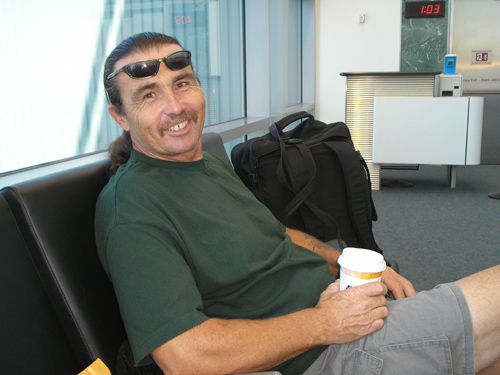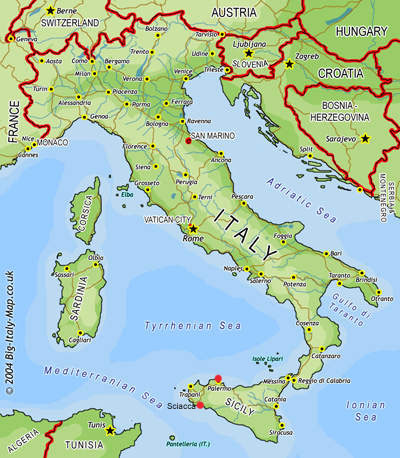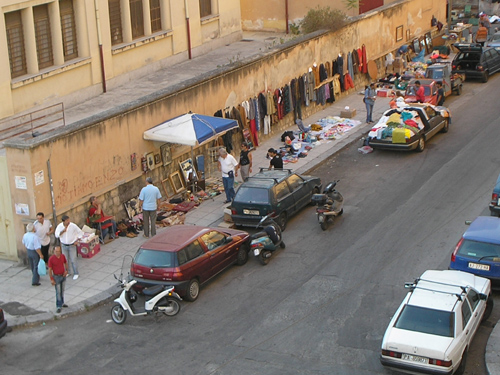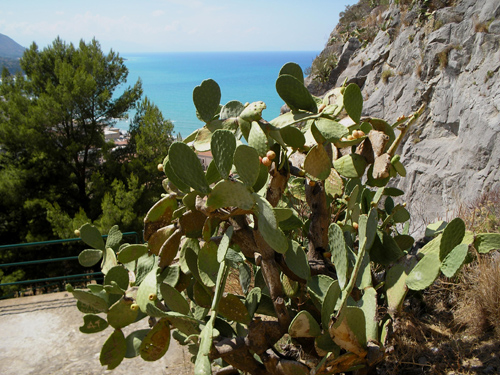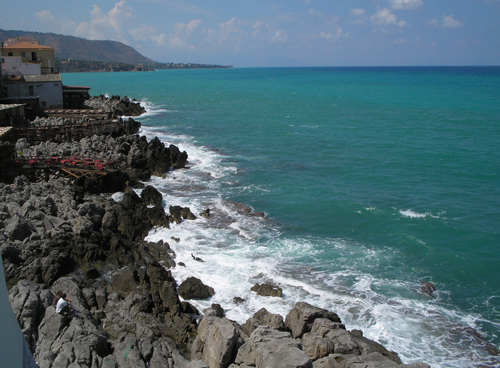The first impression of Sicily as we were touching ground was, “We’re not in Sacramento any more, Dorothy!” The next thing that smacks your senses is how very Middle Eastern this land looks: the palm trees, the color of the buildings, the terrain itself. As we cruised into the airport, we could see a massive rock mountain (2,000 ft. Mt. Pellegrino) hugging the inland horizon; the Tyrrhenian sea lapped the nearby shore.
From Punta Raisi airport (aka Falcone-Borsellino, dedicated to Giovanni Falcone and Paolo Borsellino, two anti-mafia judges killed in the early 1990’s by the Mafia), an easy train whisked us into the busy city. We got off at the Orleans station where we knew that Giorgio, the proprietor of our B&B, would be waiting for us. He was there as promised, easily recognizable with a sign that said, “Giorgio’s House.” We made our introductions and he drove us in his little, if a bit dusty, car directly to the B&B where he promptly settled us into our spacious room overlooking what would prove to be a very entertaining street.
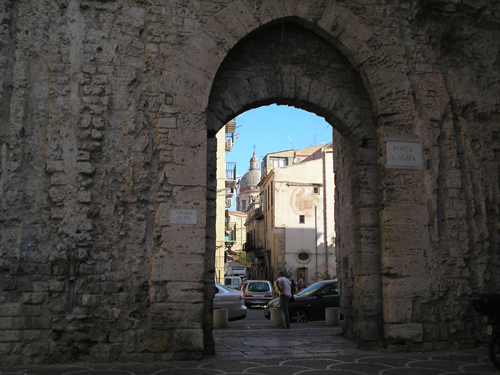
A view through la Porta Sant’Agata, one of the old city gates of Norman
origin. This one lies in the Albergheria district, which is where Giorgio’s
house is located. This area was heavily bombed during WWII and
evidence of that remains. It is a poor district, but we never felt threatened.
Giorgio’s House is a B&B like no other. It’s a couple of flights up a rather nondescript building with a neighborhood market next door. We always opted to take the stairs rather than the typically minuscule elevator. Giorgio’s B&B feels more like a communal apartment with an impromptu family that changes faces every few days, but always with our host, Giorgio, as the constant figure.
There are three separate rooms, but two communal bathrooms, a little kitchen, and a sitting/dining room. There is a TV in the sitting room, but no one ever turns it on because there is so much else to do. A small balcony affords space for dragging out a couple of chairs, providing a ringside seat to the comical traffic circus of Palermo.
The sitting room is also where every morning Giorgio brings his dizzying variety of delectably fresh pastries and Sicilian specialties. He would set out pastries along with juice and coffee and then sit with us, talking about our plans for the day, our lives back home, or whatever subject came up. This is also when he would announce the evening’s plans for those interested in joining him on various local excursions. (Be sure not to miss these! He does not charge for these little tours and you will see Palermo and outlying areas in ways not possible to be seen without him.)
We arrived in Sicily in the early evening and so had time after settling in to root out a nearby Bancomat to stock up on Euro before the first excursion at 7:45. Another couple, Louise and Leo from north of Newcastle, England, would be joining us. We all piled into Giorgio’s little car (just enough for five), and he expertly maneuvered his way through the city’s legendary traffic and up the hill to Monreale, overlooking the valley aptly named “Conca d’ora” – the golden shell.
The main attraction of this hillside town is the Duomo (cathedral), built in 1172 by King William II. One of the most impressive Duomos in Italy (and that’s saying something), the walls are gilded with incredible Greek-Byzantine mosaics. This night, however, it had already closed, so we only surveyed the outside, vowing to return during open hours. As we trudged up and around the steep and cobbled streets, we passed a group of youths dressed in folk clothing who had just finished performing at some local event. We wound around and eventually arrived at little pizza place, where we sat outside and ordered dinner. I had “Pizza Siciliana,” after which Giorgio asked me if I now felt Sicilian. I replied, “Yes!”
We chatted with Louise and Leo from England. She teaches piano and they both own a feed store. But their claim to fame is their invention: the Portabowl — a self-filling water bowl for pets. Brilliant! (I have since checked it out online and it is indeed very clever!) They were both extremely nice people, and we had a great time sharing world perspectives. Leo’s accent is quite thick, and Giorgio kept having to say, “Sorry?” (Giorgio has a charming way of responding in the affirmative with, “Yeah, yeah, yeah, yeah…sure.”)
After pizza and local wine, we continued rambling around the town. I was pleased that Giorgio’s pace was not sauntering and we stepped at a good clip. We explored an area called Ciambra, a lush warren of plant-filled alleys, greenery dripping from the walls and balconies. I was so intrigued I couldn’t wait to return during daylight, especially to take pictures. Giorgio told us this was the section of town where the workers who had built the cathedral used to live. As we walked, I noticed how the stones in the streets were black and glistening — as if someone had polished and buffed them until they gleamed.
Back at the car, we stood at the belvedere which overlooked Palermo and admired the twinkling lights that carpeted the valley. On the return drive, Giorgio took us on whirlwind carside tour through Palermo. Gino nodded in and out of consciousness after the long day of travel and excitement.
We all commented that there appeared to be no discernible traffic rules. “Only psychological ones,” Giorgio confirmed. A native of Palermo, he declared, “This traffic is in my blood.” I commented how the traffic is like a puzzle: it’s all a jumble, but somehow eventually all fits together. Giorgio also told us that Italy has more written rules than many other countries. But because of sheer volume, these rules are almost impossible to enforce and thus, most everyone simply disregards them. (This sometimes applies to laws other than traffic.)
We arrived “home” about 11:00 that night. We were beat from the day of travel and regretfully declined Leo and Louise’s invitation to join them in a glass of wine from a bottle they needed to finish before they left the next day. The spirits were willing, but the bodies had given up. Back in our room, the air was hot so we flipped on the overhead fan, opened the window, and popped in earplugs to shut out the noise of the street below.
